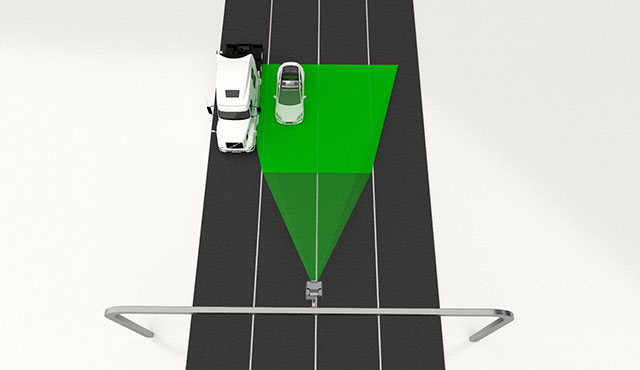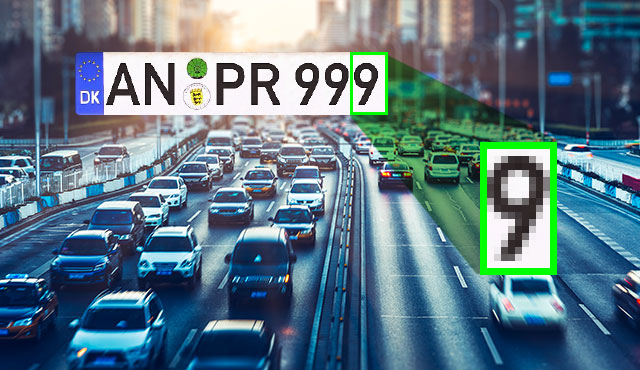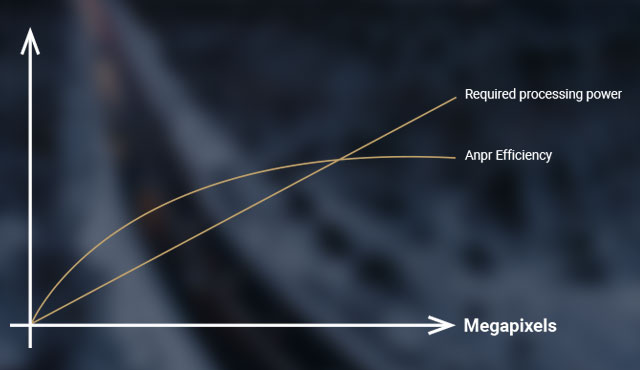In technology, we often experience “wars of numbers”. The one that you can relate to the most, is probably the innovation of our mobile phones. First, there was a battle of megapixels, demanding more, more and more. However, in the end, it turned out that it’s just one of the many factors that contribute to image quality and manufacturers started to focus on the lens instead. Then came the battle of displays: larger and larger. Then touchscreens got so large we could not even use them conveniently. Today, these parameters got balanced and we could say, such wars ended – but it did not happen immediately.
Something similar can happen even in such niche technologies as ANPR-based traffic monitoring cameras; in these years, it’s the continuous rise of megapixels. The question is whether it contributes to ANPR performance… or is just the result of vendors’ cold war of image resolution.


The major reason why ANPR camera manufacturers increase resolution is the camera’s lane coverage. As they state, the higher resolution allows a single camera to cover more lanes – so you can use less cameras for the same project. Of course, it sounds awesome from a customer’s point of view, as it seems high-tech and cost-efficient at the same time. However, we as a manufacturer also see the downside of it – so we decided to shed some light on this topic, and finally debunk the ANPR “megapixel myth”.
Fasten your seatbelts, we are doing a deep dive into ANPR (also known as ALPR for automatic license plate recognition)! If you listen closely, it will surely pay off in your next project.
How Image Resolution Affects ANPR Performance
Generally speaking, higher resolution means better recognition. It’s evident that the software has more input (data) to process, therefore it can perform with higher reliability. You have probably experienced the same when you needed to make an important decision: you can make better decisions confidently with more information.
Why Smartphone Logic Doesn’t Apply for ANPR
When people hear “5 megapixels“, they often assume it’s a limitation. After all, many smartphones boast 50MP sensors or more. But ANPR cameras are different from consumer cameras: their job is not to capture stunning, high-resolution photographs – it’s to read license plates clearly and efficiently.
Piling up megapixels without purpose only introduces challenges instead of benefits.
Minimal Image Resolution for ANPR
In practice, the minimum width of a character line on the plate should be 2 pixels – that’s the requirement of professional ALPR software, such as our Carmen® products. Below this, number plate recognition gets pretty uncertain – something that nobody wants in a traffic project.

So to calculate how much resolution we need to achieve the minimum 2-pixel character line width – let’s do the math:
Facts:
- a lane is 3.5 meters wide (on European roads)
- the width of a license plate character line is 10 mm.
Math:
- to get at least 2 pixels for a character line, we need 2 pixels for every 10mm
- a 3500mm wide lane has 350 of these 10mm sections
- therefore, 2 * 350 = at least 700 pixels will be required.
It’s important to emphasize that this number is a purely theoretical minimum that is only appropriate when there is no blur, distortion, etc., on the images – and that’s not a scenario in real life.
Optimal Image Resolution for ANPR
In our 30 years of experience, we found that the resolution will be optimal for ANPR if we double this number. This is why even our entry-level Vidar license plate recognition cameras come with HDx resolution (1440 x 1080 pixels). Capturing the traffic using such sensors results in a 4-pixel character line width on European roads and 2-3 pixels on US and Middle-East license plates.
When you evaluate license plate cameras, always remind yourself of the math. If you read that a 1920 x 1080 camera can cover three lanes, bear in mind that it’s only 640 pixels per lane, lower than the very minimum.

It’s Not Just About Megapixels: What Else Matters
A lower megapixel count paired with smart optimizations often outperforms a high-res sensor. Here’s what matters even more:
- Infrared illumination for reliable night reads.
- Shutter synchronization with vehicle movement to prevent motion blur.
- Algorithms tuned for specific local plate formats.
These factors ensure crisp, readable plates — far more efficiently than simply raising the resolution.
Multi-Lane ANPR
If you reached this part of our article, you already know that the higher resolution a camera has, the more lanes it can cover. But is it that simple? Actually, not. Covering multiple lanes by a single camera has various challenges – and some of these cannot be overcome. Read on to learn why.
Five Typical Problems of Multi-Lane ANPR
Let’s assume you do have the required resolution for covering multiple lanes, and you start to use an ANPR camera for three or even four lanes. Though it sounds good, number plate recognition results will not shine that much. Our recommendation is not to go above two lanes. Here are five reasons to prove it.
Blocked View
Larger vehicles may block the view of smaller ones passing by in an adjacent lane, leading to the possibility of missed events.
Processing Power
The more lanes you cover, the higher processing power you will need. The chance of missed events, delays, and network overload will increase as the number of lanes increases.
High Resolution
When it comes to ALPR systems, the formula is simple: the bigger the picture resolution, the bigger the file — and the more data the system must handle. This strains bandwidth, slows down storage, and requires heavier processing, especially in mobile, real-time, or edge deployments.
However, traffic cameras are designed to endure extreme conditions while remaining cost-effective. Because of this, they often use CPUs that prioritize durability and efficiency over raw computational power. Limited processing capabilities mean that if the camera has to work through oversized high-resolution images, it can slow down real-time performance. Since fewer frames can be processed under these conditions, accurate triggering becomes more crucial than ever.
Here’s a breakdown of why excessive megapixels can work against ANPR performance:
- Increased Data Volume
Higher resolution means bigger image files, which puts pressure on data transmission, processing, and storage – crucial factors in bandwidth- or memory-limited environments. - Slower Processing Times
Optical Character Recognition (OCR) must analyze more pixels per frame, increasing latency and risking missed plate reads when vehicles move at speed. - Wasted Resources
In license plate recognition, only a small portion of the image – the plate itself – actually matters. Processing millions of unnecessary background pixels wastes valuable resources without improving recognition performance.
Adaptive Recognition’s flagship Vidar ALPR camera elegantly addresses these challenges.
It uses a 5MP sensor – not because of limitation, but by design. Thanks to purpose-built optics, image processing, and software tuning, Vidar consistently captures sharp license plate images even at highway speeds, while keeping processing fast and memory use minimal. Furthermore, Vidar combines three powerful triggering methods – Plate Finder, the virtual loop, and the industry-first built-in laser trigger – to ensure that plates are detected efficiently even under demanding conditions. In ANPR, smart engineering beats raw pixel count every time.
Unlike conventional designs, Vidar’s architecture includes two separate processors: a dual-core CPU for system operations and a quad-core CPU dedicated entirely to ANPR tasks. This division of labor allows Vidar to handle high-resolution imaging when needed, while still maintaining economical operation, industry-standard durability, and uncompromised recognition accuracy.
Lens Aberrations
Even the best lenses have so-called aberrations: there is a difference in image quality between the middle and the side of the image. Getting closer to the sides, the image becomes less sharp, a bit faded, and distorted, harming ANPR performance.
Evidence
In many countries, a traffic image is admissible evidence to the court when it shows only one vehicle. Images showing multiple vehicles are not accepted for such legal procedures. So unless you have a feature that cuts out each vehicle, this may also be an issue.
Three Tips for Multi-Lane ANPR
Our recommendation is to use a camera for one lane or a maximum of two lanes – however, if your camera captures multiple lanes, make sure to follow our professional guidance. We collected three tips to achieve the best possible performance.
- The minimum image resolution should be at least 700 pixels per lane or, ideally, 1440 pixels per lane (in an HDx camera).
- Use only the overhead installation instead of the lateral position. This way, you can minimize missed events (due to blocked view) and distortion.
- Make use of your dedicated ANPR cameras’ synchronized and focused illumination features. However, the most up-to-date models, such as the Vidar license plate recognition camera, can go even further. By being capable of auto-adjusting the brightness for odd and even frames simultaneously, Vidar can take ANPR-compatible pictures of reflective and non-reflective license plates without the need for additional illumination.
We hope you find this guide useful. If you are still uncertain how to position your camera and what parameters you need for the best performance, feel free to get in touch with us – our experts are always glad to share their knowledge:

